Assessing the Role of Forest Grazing in Reducing Fire Severity: A Mitigation Strategy
Abstract
1. Introduction
2. Material and Methods: Applied Methodology
2.1. Fire Simulator Characteristics: FlamMap
2.2. Study Area
2.3. Field Data Gathering
2.4. Input Data: Landscape Preparation
- The elevation, slope, and aspect from a digital elevation model (DEM)
- The fuel model map;
- The characteristics of the tree canopy cover, namely, the canopy cover, canopy height, canopy base height, and bulk density.
- Input and output raster files with a resolution of 10 m.
2.5. Definition of the Fuel Model
3. Results and Discussion
- ▪
- Grazing has a profound impact on fire severity, transforming it from high to extreme levels to low levels across all grazed scenarios.
- ▪
- The highest severity is observed in ungrazed areas exposed to low to medium humidity, resulting in a greater accumulation of dehydrated fuel, estimated at 3.4 tons per hectare (t/ha) over a 1-hectare area.
- ▪
- Conversely, the lowest severity occurs in grazed regions with high tree cover and elevated humidity, which correlate with a reduced fuel load of 1.38 t/ha on a 1-hectare scale (Table 2).
- Biomass Consumption: The biomass consumed by grazing cattle through forage feeding was estimated, revealing that approximately 33% of the fine fuel data (1 ha diameter class 0–0.6 cm) was eliminated due to grazing, which averaged 0.75 t/ha of forage.
- Severity Mapping: Cartographic processing of severity maps indicated that grazing significantly reduced fire severity. Areas that remained ungrazed exhibited higher severity in low to medium humidity environments, with a fuel load of 3.4 t/ha, whereas grazed areas with high tree cover and humidity recorded a lower fuel load of 1.38 t/ha.
- Impact of Grazing: The most significant reductions in fire-related parameters (FL, ROS, and FLI) occurred in high-canopy cover areas during wet years (GHW20–UHW21), with decreases of 41%, 58%, and 68%, respectively. Across nearly all studied scenarios, grazing effectively mitigated fire severity, achieving reductions ranging from 15% to 68%.
- Statistical Analysis: ANOVA confirmed that grazing is a critical factor in reducing parameters indicative of fire severity, solidifying its role in fire management strategies.
- Fire Spread Reduction: Utilizing the minimum travel time (MTT) technique, a map generated from a single ignition point demonstrated that grazing reduced the extent of fire spread by 25.9% in wet years, 60.9% in median years, and 45.8% in dry years.
4. Conclusions
Author Contributions
Funding
Institutional Review Board Statement
Informed Consent Statement
Data Availability Statement
Acknowledgments
Conflicts of Interest
References
- Rovithakis, A.; Grillakis, M.G.; Seiradakis, K.D.; Giannakopoulos, C.; Karali, A.; Field, R.; Lazaridis, M.; Voulgarakis, A. Future climate change impact on wildfire danger over the Mediterranean: The case of Greece. Environ. Res. Lett. 2022, 17, 045022. [Google Scholar] [CrossRef]
- San-Miguel-Ayanz, J.; Durrant, T.; Boca, R.; Maianti, P.; Liberta, G.; Artes Vivancos, T.; Jacome Felix Oom, D.; Branco, A.; De Rigo, D.; Ferrari, D.; et al. Forest Fires in Europe, Middle East and North Africa; EUR 31269 EN; Publications Office of the European Union: Luxembourg, 2021. [Google Scholar]
- IPBES. Global Assessment Report on Biodiversity and Ecosystem Services of the Intergovernmental Science-Policy Platform on Biodiversity and Ecosystem Services; Brondizio, E.S., Settele, J., Díaz, S., Ngo, H.T., Eds.; IPBES Secretariat: Bonn, Germany, 2019; 1148p. [Google Scholar]
- Simpson, C.; Bonjean, I.; Fornara, M.; Jonkers, K.; Klaassen, T.; Lehto, S.; Soldatova, L.; Thielen Del Pozo, J.; Westra Van Holthe, M. (Eds.) JRC Highlights Report; Publications Office of the European Union: Luxembourg, 2024. [Google Scholar]
- Silva, P.; Carmo, M.; Rio, J.; Novo, I. Changes in the Seasonality of Fire Activity and Fire Weather in Portugal: Is the Wildfire Season Really Longer? Meteorology 2023, 2, 74–86. [Google Scholar] [CrossRef]
- Turco, M.; Rosa-Cánovas, J.J.; Bedia, J.; Jerez, S.; Montávez, J.P.; Llasat, M.C.; Provenzale, A. Exacerbated fires in Mediterranean Europe due to anthropogenic warming projected with non-stationary climate-fire models. Nat. Commun. 2018, 9, 3821. [Google Scholar] [CrossRef]
- Rouet-Leduc, J.; Pe’Er, G.; Moreira, F.; Bonn, A.; Helmer, W.; Zadeh, S.A.A.S.; Zizka, A.; van der Plas, F. Effects of large herbivores on fire regimes and wildfire mitigation. J. Appl. Ecol. 2021, 58, 2690–2702. [Google Scholar] [CrossRef]
- Moreira, F.; Ascoli, D.; Safford, H.; A Adams, M.; Moreno, J.M.; Pereira, J.C.; Catry, F.X.; Armesto, J.; Bond, W.J.; E González, M.; et al. Wildfire management in Mediterranean-type regions: Paradigm change needed. Environ. Res. Lett. 2020, 15, 011001. [Google Scholar] [CrossRef]
- Ascoli, D.; Plana, E.; Oggioni, S.D.; Tomao, A.; Colonico, M.; Corona, P.; Moreno, F.; Xanthopoulos, G.; Kaoukis, K.; Athanasiou, M.; et al. Fire-smart solutions for sustainable wildfire risk prevention: Bottom-up initiatives meet top-down policies under EU green deal. Int. J. Disaster Risk Reduct. 2023, 92, 103715. [Google Scholar] [CrossRef]
- Oikonomou, D.; Vrahnakis, M.; Yiakoulaki, M.; Xanthopoulos, G.; Kazoglou, Y. Grazing as a management tool in Mediterranean Pastures: A meta-analysis based on a literature review. Land 2023, 12, 1290. [Google Scholar] [CrossRef]
- Ribeiro, I.; Domingos, T.; McCracken, D.; Proença, V. The use of domestic herbivores for ecosystem management in Mediterranean Landscapes. Glob. Ecol. Conserv. 2023, 46, e02577. [Google Scholar] [CrossRef]
- Smit, I.P.J.; Coetsee, C. Interactions Between Fire and Herbivory: Current Understanding and Management Implications. In The Ecology of Browsing and Grazing II. Ecological Studies; Gordon, I., Prins, H., Eds.; Springer: Cham, Switzerland, 2019; Volume 239. [Google Scholar]
- Allen, V.G.; Batello, C.; Berretta, E.J.; Hodgson, J.; Kothmann, M.; Li, X.; McIvor, J.; Milne, J.; Morris, C.; Peeters, A.; et al. An international terminology for grazing lands and grazing animals. Grass Forage Sci. 2011, 66, 2–28. [Google Scholar] [CrossRef]
- Vacchiano, G.; Foderi, C.; Berretti, R.; Marchi, E.; Motta, R. Modeling anthropogenic and natural fire ignitions in an inner-Alpine valley. Nat. Hazards Earth Syst. Sci. 2018, 18, 935–948. [Google Scholar] [CrossRef]
- Starns, H.D.; Fuhlendorf, S.D.; Elmore, R.D.; Twidwell, D.; Thacker, E.T.; Hovick, T.J.; Luttbeg, B. Recoupling fire and grazing reduces wildland fuel loads on rangelands. Ecosphere 2019, 10, e02578. [Google Scholar] [CrossRef]
- Ngugi, M.W.; Kimuyu, D.M.; Sensenig, R.L.; Odadi, W.O.; Kiboi, S.K.; Omari, J.K.; Young, T.P. Fire and herbivory interactively suppress the survival and growth of trees in an African semiarid savanna. Fire 2022, 5, 169. [Google Scholar] [CrossRef]
- Kramer, K.; Groen, T.; van Wieren, S. The interacting effects of ungulates and fire on forest dynamics: An analysis using the model FORSPACE. For. Ecol. Manag. 2003, 181, 205–222. [Google Scholar] [CrossRef]
- Pausas, J.G.; Keeley, J.E. Abrupt climate-independent fire regime changes. Ecosystems 2014, 17, 1109–1120. [Google Scholar] [CrossRef]
- Bachelet, D.; Lenihan, J.M.; Daly, C.; Neilson, R.P. Interactions between fire, grazing and climate change at Wind Cave National Park, SD. Ecol. Model. 2000, 134, 229–244. [Google Scholar] [CrossRef]
- Wagner, M.; Waterton, C.; Norton, L.R. Mob grazing: A nature-based solution for British farms producing pasture-fed livestock. Nat.-Based Solut. 2023, 3, 100054. [Google Scholar] [CrossRef]
- Li, D.; Zhang, M.; Lü, X.; Hou, L. Does nature-based solution sustain grassland quality? evidence from rotational grazing practice in China. J. Integr. Agric. 2023, 22, 2567–2576. [Google Scholar] [CrossRef]
- Cohen-Shacham, E.; Walters, G.; Janzen, C.; Maginnis, S. (Eds.) Nature-Based Solutions to Address Global Societal Challenges; Imprint Gland IUCN: Gland, Switzerland, 2016. [Google Scholar]
- Bayer, J.; Bacciu, V.; Plana, E.; Sousa, L.; Surminski, S.; Deubelli-Hwang, T. Nature-based solutions for Wildfire Risk Management. In Proceedings of the EGU General Assembly, Vienna, Austria, 23–28 April 2023. [Google Scholar]
- Launchbaugh, K.; Walker, J. Targeted grazing—A new paradigm for livestock management. In Targeted Grazing: A Natural Approach to Vegetation Management and Landscape Enhancement; Launchbaugh, K., Ed.; American Sheep Industry Association ASI: Washington, DC, USA, 2006; p. 8. [Google Scholar]
- Ainalis, A.B.; Platis, P.D.; Meliadis, I.M. Grazing effects on the sustainability of an oak coppice forest. For. Ecol. Manag. 2010, 259, 428–432. [Google Scholar] [CrossRef]
- Lovreglio, R.; Meddour-Sahar, O.; Leone, V. Goat grazing as a wildfire prevention tool: A basic review. iForest 2014, 7, 260–268. [Google Scholar] [CrossRef]
- Huntsinger, L.; Barry, S. Grazing in California’s Mediterranean multi-firescapes. Front. Sustain. Food Syst. 2021, 5, 24. [Google Scholar] [CrossRef]
- Castaldo, A.G. On the Quest of Prescribed Grazing Multi-Functionality in Mediterranean A Nature-Based Solutions Framework for Wildfire Risk Management. Ph.D. Thesis, Politecnico di Milano, Millan, Italy, 2023. [Google Scholar]
- Finney, M.A. An overview of FlamMap fire modeling capabilities. In Fuels Management—How to Measure Success: Conference Proceedings. RMRS-P-41; Andrews, P.L., Butler, B.W., Eds.; USDA Forest Service, Rocky Mountain Research Station: Portland, OR, USA, 2006; pp. 213–220. [Google Scholar]
- Rothermel, R.C. A mathematical model for predicting fire spread in wildland fuels. In Research Paper INT-115, USDA Forest Service; Intermountain Forest and Range Experiment Station: Ogden, UT, USA, 1972; p. 40. [Google Scholar]
- Life Montserrat Project Team. LIFE Montserrat: Enhancing Forest Resilience Through Grazing and Ecosystem-Based Management in Catalonia, Spain. European Union LIFE Programme. 2024. Available online: www.lifemontserrat.eu (accessed on 1 January 2023).
- Ning, J.; Yang, G.; Liu, X.; Geng, D.; Wang, L.; Li, Z.; Zhang, Y.; Di, X.; Sun, L.; Yu, H. Effect of fire spread, flame characteristic, fire intensity on particulate matter 2.5 released from surface fuel combustion of Pinus koraiensis plantation—A laboratory simulation study. Environ. Int. 2022, 166, 107352. [Google Scholar] [CrossRef] [PubMed]
- Farsite, F.M. Fire Area Simulator-Model Development and Evaluation. Research Paper RMRS-RP-4; revised 2004; USDA Forest Service, Rocky Mountain Research Station: Ogden, UT, USA, 1998; 47p.
- Salis, M.; Arca, B.; Bacciu, V.; Duce, P.; Spano, D. Assessment of fire severity in a mediterranean area using FlamMap simulator. In Proceeding of the VIII Symposiumon on Fire and Forest Meteorology, Kalispell, MT, USA, 13–15 October 2009. [Google Scholar]
- Arca, B.; Pellizzaro, G.; Duce, P.; Salis, M.; Bacciu, V.; Spano, D.; Ager, A.; Scoccimarro, E. Potential changes in fire probability and severity under climate change scenarios in Mediterranean areas. Model. Fire Behav. Risk 2012, 1, 92–98. [Google Scholar]
- Arpaci, A.; Vacik, H.; Valese, E. Potential Fire Intensities in the Alpine Region based on characteristic fuels in Austria and Italy. In Proceedings of the 5th International Wildland Fire Conference, Sun City, South Africa, 9–13 May 2011. [Google Scholar]
- Pulina, A.; Lai, R.; Salis, L.; Seddaiu, G.; Roggero, P.P.; Bellocchi, G. Modeling pasture production and soil temperature, water and carbon fluxes in Mediterranean grassland systems with the Pasture Simulation model. Grass Forage Sci. 2018, 73, 272–283. [Google Scholar] [CrossRef]
- De Martonne, E. Nouvelle carte mondiale de l’indice d’aridité. Ann. Géogr. 1942, 51, 242–250. (In French) [Google Scholar] [CrossRef]
- Seddaiu, G.; Bagella, S.; Pulina, A.; Cappai, C.; Salis, L.; Rossetti, I.; Lai, R.; Roggero, P.P. Mediterranean cork oak wooded grasslands: Synergies and trade-offs between plant diversity, pasture production and soil carbon. Agrofor. Syst. 2018, 92, 893–908. [Google Scholar] [CrossRef]
- USDA. Soil Survey Staff Keys to Soil Taxonomy, 13th ed.; USDA-Natural Resources Conservation Service: Washington, DC, USA, 2022.
- Seddaiu, G.; Porcu, G.; Ledda, L.; Roggero, P.P.; Agnelli, A.; Corti, G. Soil organic matter content and composition as influenced by soil management in a semi-arid Mediterranean agro-silvo-pastoral system. Agric. Ecosyst. Environ. 2013, 167, 1–11. [Google Scholar] [CrossRef]
- Bagella, S.; Caria, M.C. Vegetation series: A tool for the assessment of grassland ecosystem services in Mediterranean large-scale grazing systems. Fitosociologia 2011, 48, 47–54. [Google Scholar]
- UCP Knowledge Network. The Value of Grazing as a Wildfire Prevention Tool. European Civil Protection Knowledge Network. 2024. Available online: https://civil-protection-knowledge-network.europa.eu/ (accessed on 1 January 2023).
- Jose, S.; Dollinger, J. Silvopasture: A sustainable livestock production system. Agrofor. Syst. 2019, 93, 1–9. [Google Scholar] [CrossRef]
- Pulina, A.; Campus, S.; Cappai, C.; Roggero, P.P.; Salis, L.; Seddaiu, G. Tree cover influences the soil C balance in Mediterranean cork oak-based silvopastoral systems. Soil Tillage Res. 2022, 15, 105234. [Google Scholar] [CrossRef]
- Ascoli, D.; Vacchiano, G.; Scarpa, C.; Arca, B.; Barbati, A.; Battipaglia, G.; Elia, M.; Esposito, A.; Garfì, V.; Lovreglio, R.; et al. Harmonized dataset of surface fuels under Alpine, temperate and Mediterranean conditions in Italy. A synthesis supporting fire management. iForest 2020, 13, 513–522. [Google Scholar] [CrossRef]
- Campbell-Lochrie, Z.; Walker-Ravena, C.; Gallagher, M.; Skowronski, N.; Mueller, E.V.; Hadden, R.M. Effects of fuel bed structure on heat transfer mechanisms within and above porous fuel beds in quiescent flame spread scenarios. Int. J. Wildland Fire 2023, 32, 913–926. [Google Scholar] [CrossRef]
- Riedo, M.; Grub, A.; Rosset, M.; Fuhrer, J. A pasture simulation model for dry matter production, and fluxes of carbon, nitrogen, water and energy. Ecol. Model. 1998, 105, 141–183. [Google Scholar] [CrossRef]
- Nicks, A.; Richardson, C.; Williams, J. Evaluation of the EPIC model weather generator. In EPIC-Erosion/Productivity Impact Calculator; Sharpley, A., Williams, J., Eds.; USDA: Beltsville, MD, USA, 1990; pp. 105–124. [Google Scholar]
- Montero, G.; Ruiz-Peinado, R.; Munoz, M. Producción de Biomasa y Fijación de CO2 por los Bosques Espanoles; Monografías INIA. Serie Forestal; INIA-Instituto Nacional de Investigación y Tecnología Agraria y Alimentaria: Madrid, Spain, 2005; Volume 13, p. 5. [Google Scholar]
- Batcheler, M.; Smith, M.M.; Swanson MEOstrom, M.; Caroenter-Boggs, L. Assessing silvopasture management as a strategy to reduce fuel loads and mitigate wildfire risk. Sci. Rep. 2024, 14, 5954. [Google Scholar] [CrossRef]
- García De Jalón, S.; Graves, A.; Moreno, G.; Palma, J.H.N.; Crous-Durán, J.; Kay, S.; Burgess, P.J. Forage-SAFE: A model for assessing the impact of tree cover on wood pasture profitability. Ecol. Model. 2018, 372, 24–32. [Google Scholar] [CrossRef]
- Shriya, G.; Rajendra, K.R.; Satish Chandra, G. Effect of tree canopy on herbaceous vegetation and soil characteristics in semi-arid forests of the Aravalli hills. Arid Land Res. Manag. 2022, 36, 224–242. [Google Scholar]
- Skowronski, N.S.; Gallagher, M.R.; Warner, T.A. Decomposing the Interactions between Fire Severity and Canopy Fuel Structure Using Multi-Temporal, Active, and Passive Remote Sensing Approaches. Fire 2020, 3, 7. [Google Scholar] [CrossRef]
- Bertomeu, M.; Pineda, J.; Pulido, F. Managing wildfire risk in mosaic landscapes: A case study of the upper gata river catchment in Sierra de Gata, Spain. Land 2022, 11, 465. [Google Scholar] [CrossRef]
- Rossa, C.G.; Fernandes, P.M. Fuel-related fire-behaviour relationships for mixed live and dead fuels burned in the laboratory. Can. J. For. Res. 2017, 47, 883–889. [Google Scholar] [CrossRef]
- Fernandes, P.M.; Botelho, H.S.; Rego, F.C.; Loureiro, C. Empirical modelling of surface fire behaviour in maritime pine stands. Int. J. Wildland Fire 2009, 18, 698–710. [Google Scholar] [CrossRef]
- Byram, G.M. Combustion of Forest Fuels. In Forest Fire: Control and Use; Davis, K.P., Ed.; McGraw-Hill: New York, NY, USA, 1959; pp. 61–89. [Google Scholar]
- Andrews, P.L. Modeling Wind Adjustment Factor and Midflame Wind Speed for Rothermel’s Surface Fire Spread Model; U.S Department of Agriculture, Forest Service, Rocky Mountain Research Station: Fort Collins, CO, USA, 2012; 39p.



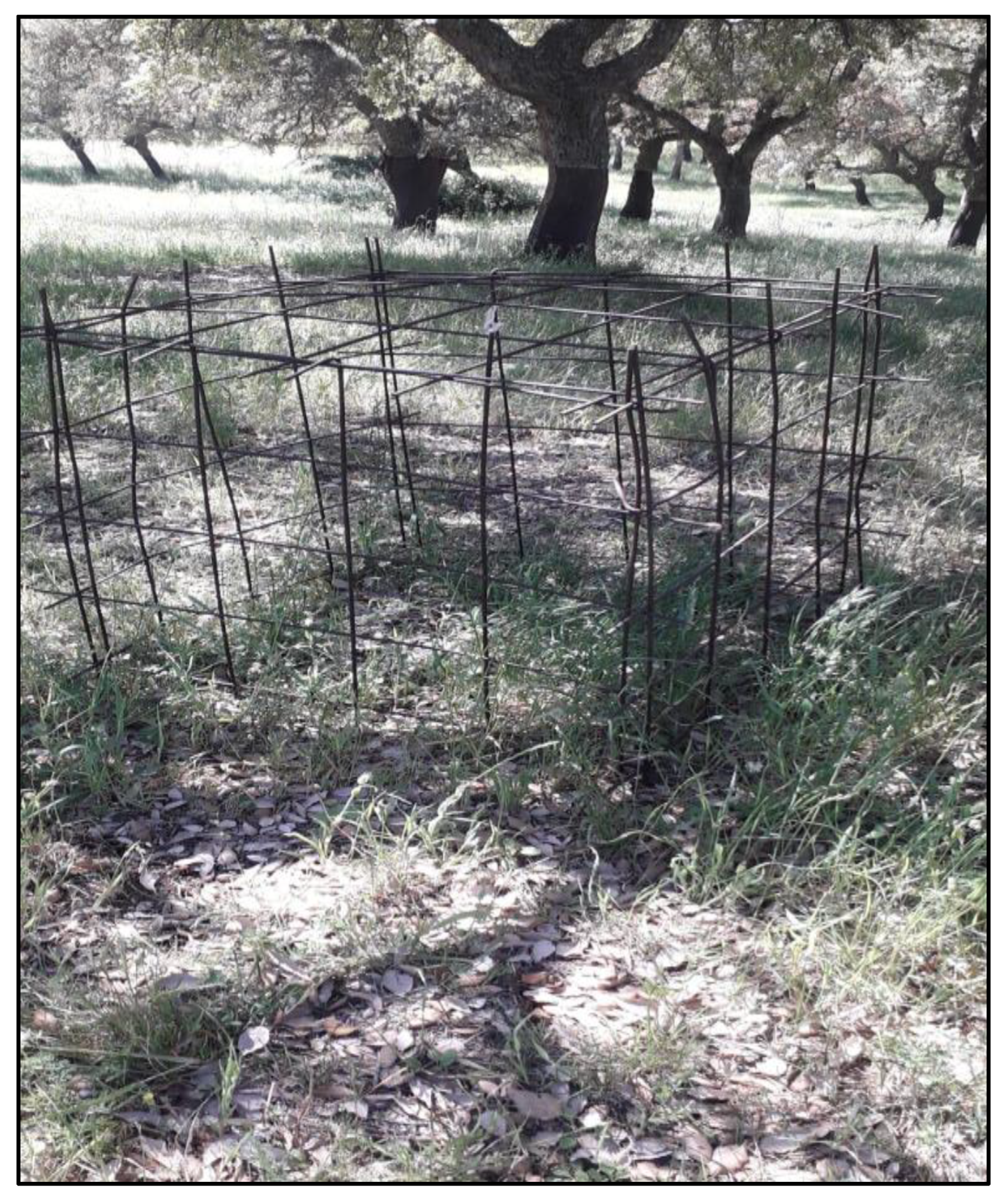
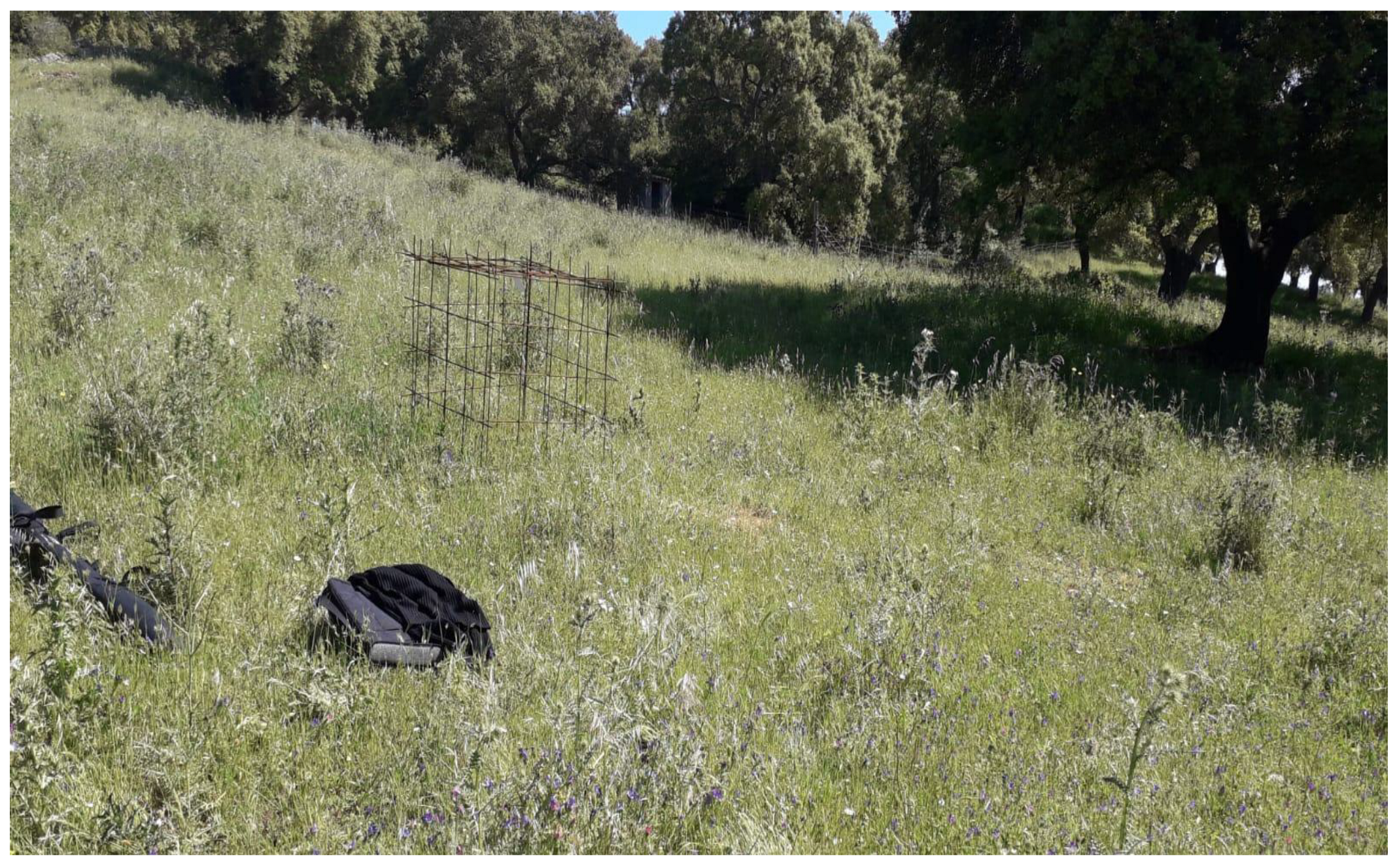
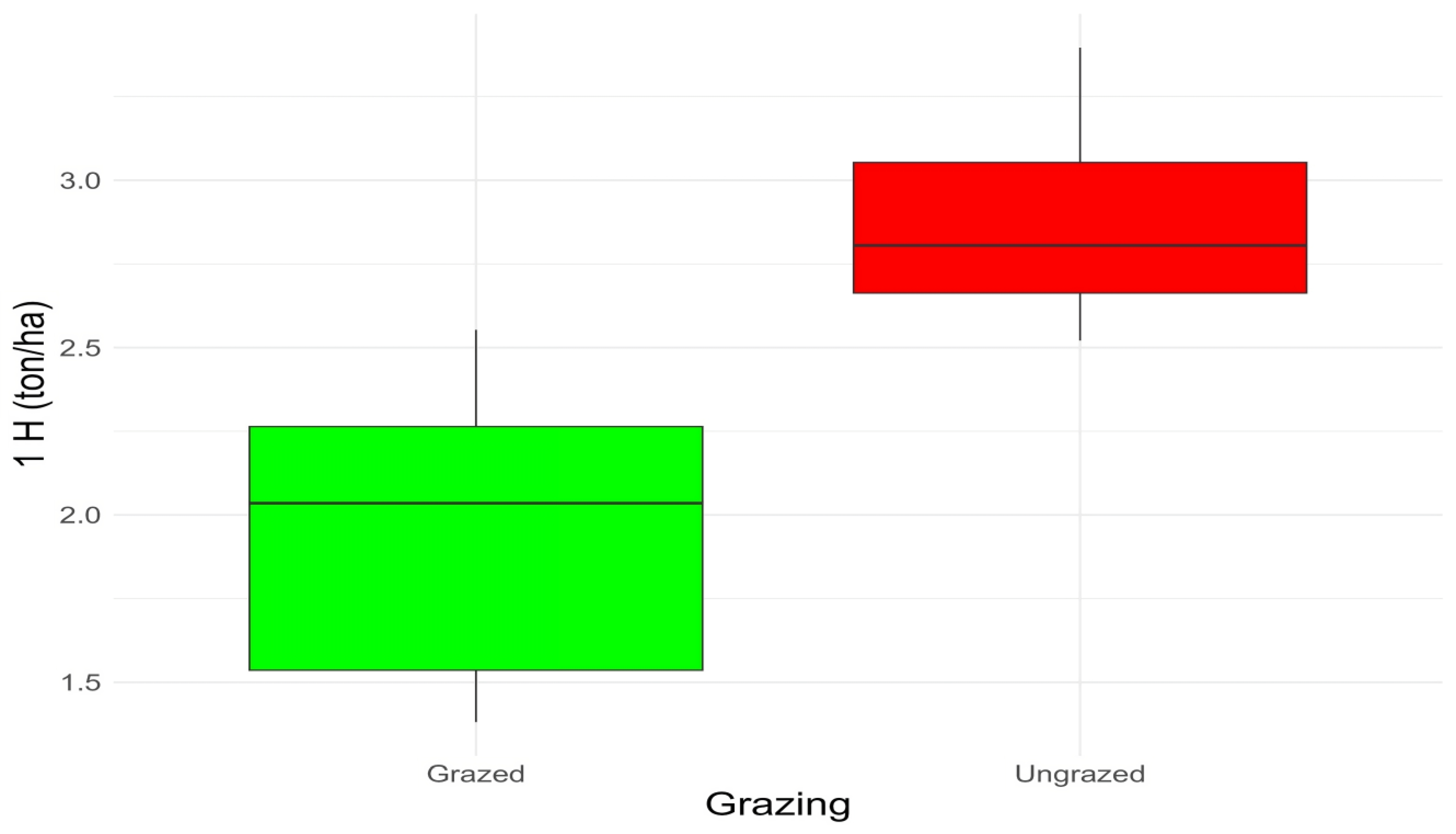
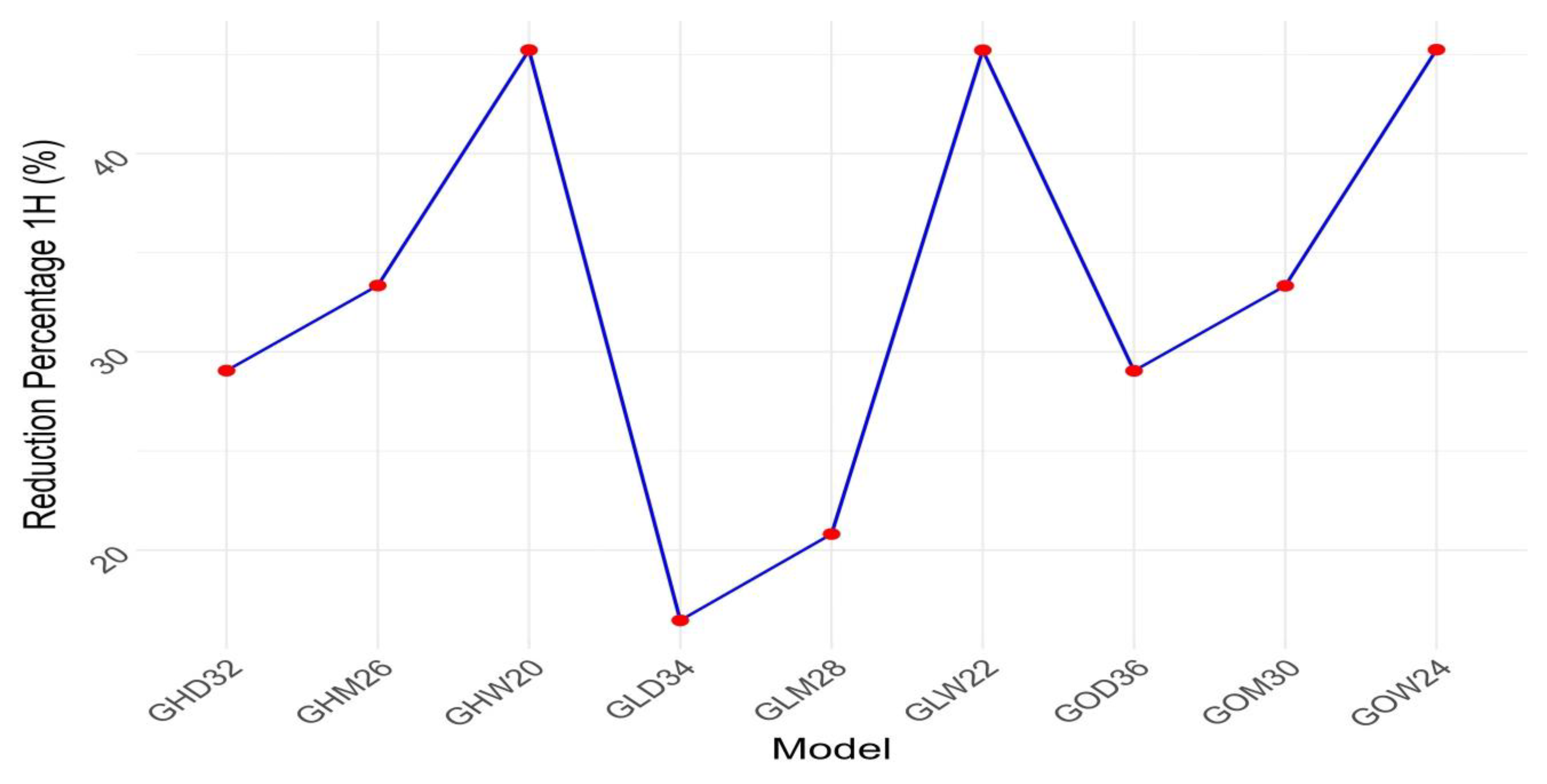
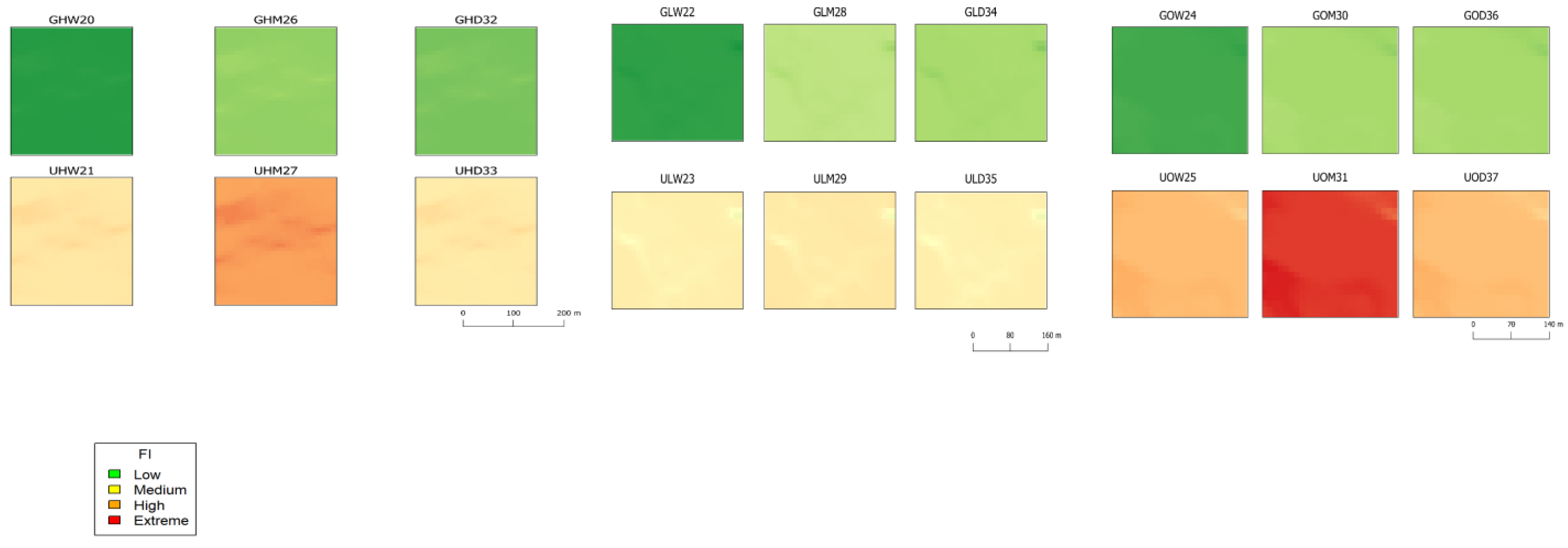



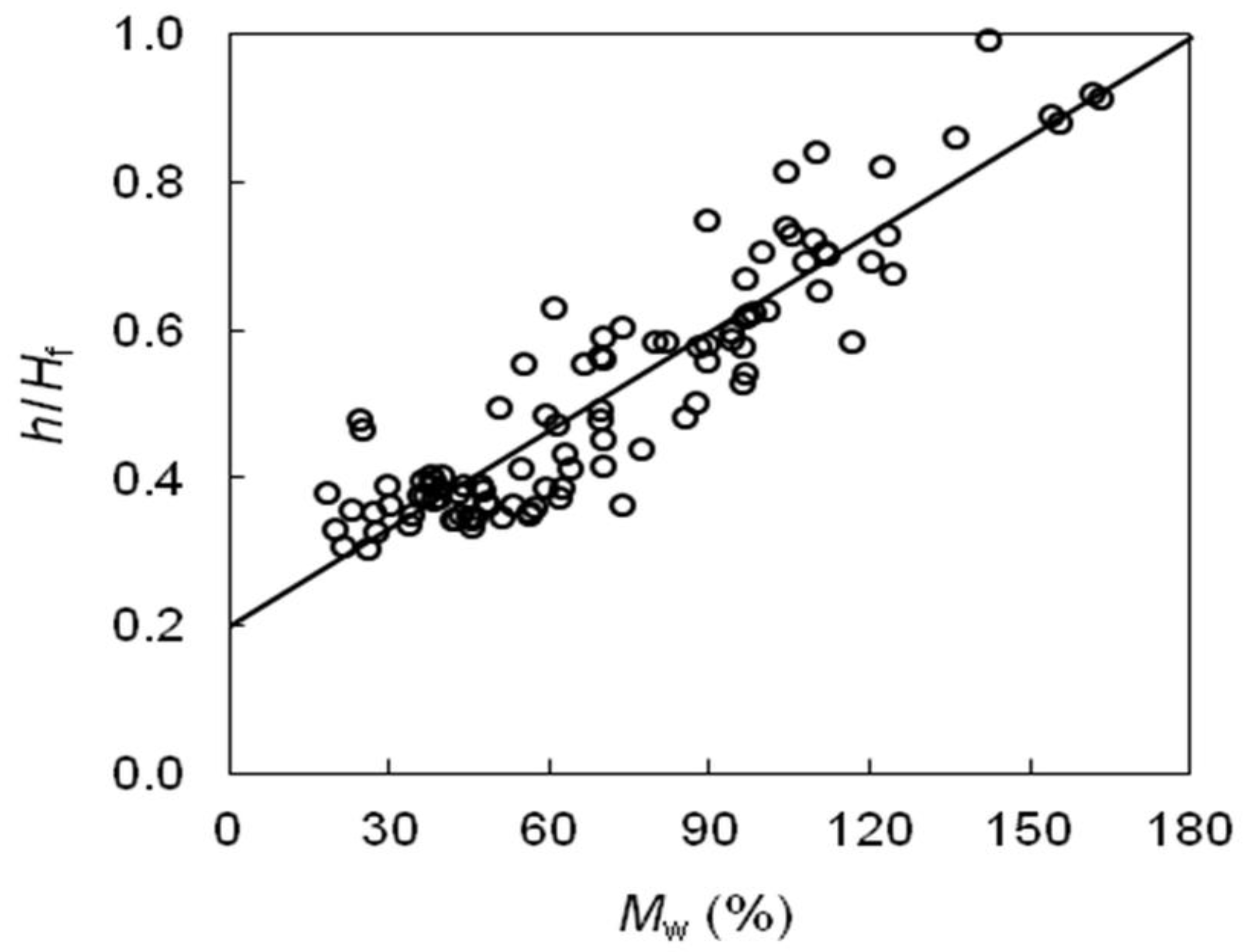

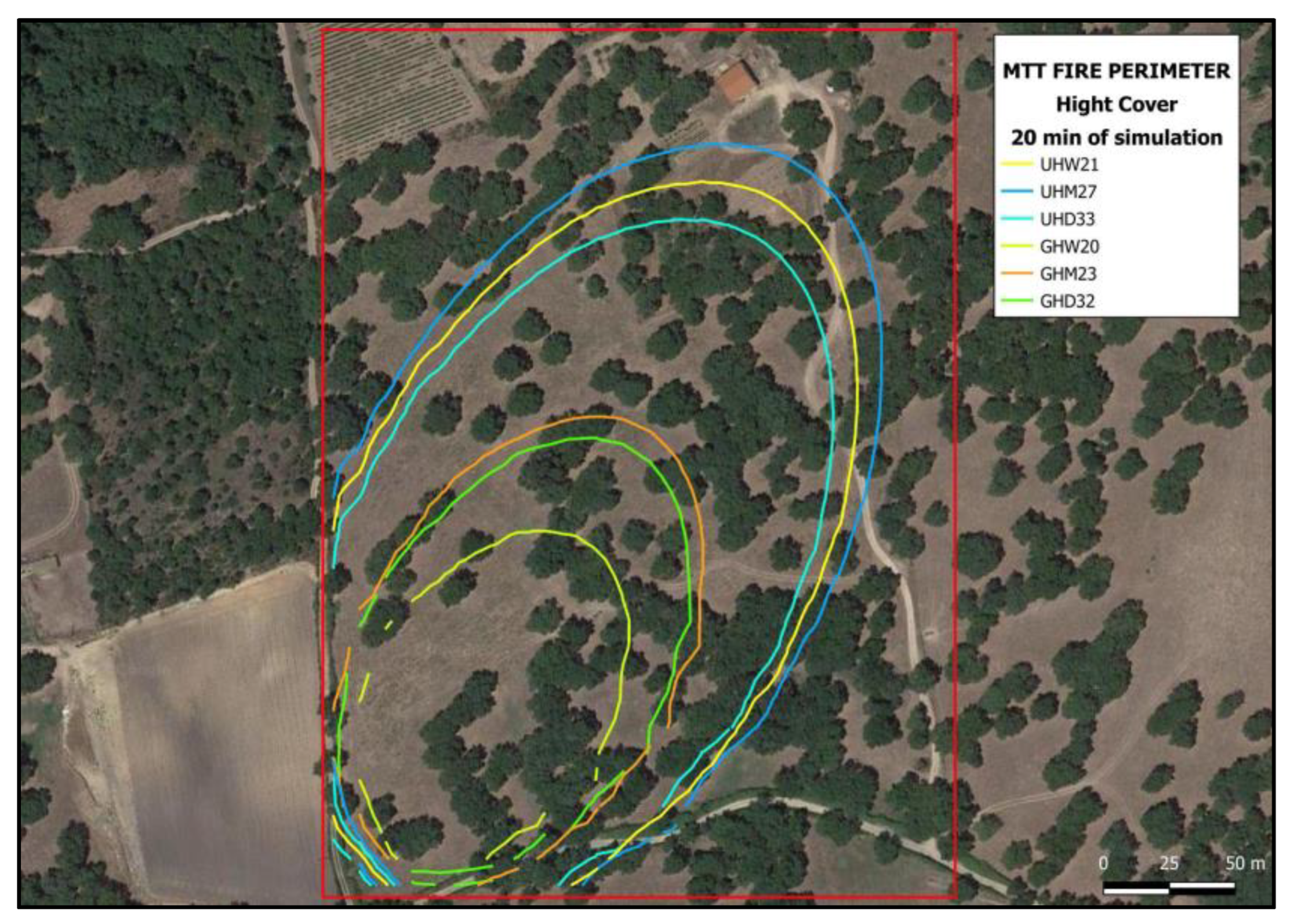
| FMCode | FMName | FMCode | FMName | FMCode | FMName |
|---|---|---|---|---|---|
| GHW20 | Grazed high-density wet year | GHM26 | Grazed high-density median year | GHD32 | Grazed high-density dry year |
| UHW21 | Ugnrazed high-density wet year | UHM27 | Ugnrazed high-density median year | UHD33 | Ugnrazed high-density dry year |
| GLW22 | Grazed low-density wet year | GLM28 | Grazed low-density median year | GLD34 | Grazed low-density dry year |
| ULW23 | Unrazed low-density wet year | ULM29 | Unrazed low-density median year | ULD35 | Unrazed low-density dry year |
| GOW24 | Grazed open area wet year | GOM30 | Grazed open area median year | GOD36 | Grazed open area dry year |
| UOW25 | Ungrazed open area wet year | UOM31 | Ungrazed open area median year | UOD37 | Ungrazed open area dry year |
| FMCode | FL Mean | FL Max | FL Min | ROS Mean | ROS Max | ROS Min | FLI Mean | FLI Max | FLI Min | |
|---|---|---|---|---|---|---|---|---|---|---|
| m | m | m | m/min | m/min | m/min | kWm−1 | kWm−1 | kWm−1 | ||
| Wet Year Fuel Conditions | GHW20 | 1.0 | 1.1 | 1.0 | 7.0 | 7.3 | 6.8 | 281.2 | 298.4 | 275.7 |
| UHW21 | 1.8 | 1.8 | 1.8 | 15.1 | 15.9 | 14.8 | 897.1 | 943.9 | 882.0 | |
| GLW22 | 1.1 | 1.1 | 1.0 | 6.7 | 6.8 | 5.7 | 298.3 | 305.6 | 256.3 | |
| ULW23 | 1.7 | 1.8 | 1.6 | 11.1 | 11.3 | 9.8 | 860.3 | 877.2 | 762.1 | |
| GOW24 | 1.1 | 1.2 | 1.1 | 7.3 | 7.7 | 7.7 | 335.4 | 352.7 | 307.2 | |
| UOW25 | 1.9 | 1.9 | 1.8 | 14.2 | 14.8 | 13.2 | 1038.8 | 1083.8 | 965.2 | |
| Median Year Fuel Conditions | GHM26 | 1.4 | 1.4 | 1.3 | 9.5 | 10.1 | 9.3 | 499.3 | 528.0 | 490.1 |
| UHM27 | 2.0 | 2.0 | 1.9 | 16.0 | 16.8 | 15.7 | 1116.1 | 1173.7 | 1097.5 | |
| GLM28 | 1.5 | 1.5 | 1.4 | 9.1 | 9.3 | 7.9 | 609.0 | 623.2 | 527.3 | |
| ULM29 | 1.8 | 1.8 | 1.7 | 9.1 | 9.2 | 8.0 | 880.0 | 897.7 | 777.5 | |
| GOM30 | 1.5 | 1.5 | 1.4 | 10.0 | 10.5 | 9.2 | 600.9 | 630.1 | 553.0 | |
| UOM31 | 2.1 | 2.1 | 2.0 | 15.0 | 15.7 | 13.9 | 1303.2 | 1359.4 | 1211.2 | |
| Dry Year Fuel Conditions | GHD32 | 1.3 | 1.3 | 1.3 | 9.1 | 9.6 | 8.9 | 474.7 | 474.7 | 440.3 |
| UHD33 | 1.8 | 1.8 | 1.7 | 14.2 | 14.9 | 13.9 | 884.7 | 931.5 | 869.6 | |
| GLD34 | 1.4 | 1.4 | 1.3 | 8.7 | 8.9 | 7.5 | 545.7 | 558.5 | 471.9 | |
| ULD35 | 1.7 | 1.7 | 1.6 | 10.4 | 10.6 | 9.2 | 857.2 | 874.4 | 757.5 | |
| GOD36 | 1.4 | 1.4 | 1.3 | 9.5 | 10.0 | 8.8 | 538.8 | 565.1 | 495.5 | |
| UOD37 | 1.9 | 1.9 | 1.8 | 13.3 | 13.9 | 12.4 | 1028.7 | 1074.0 | 954.5 |
| FL Mean | ROS Mean | FLI Mean | ||||
|---|---|---|---|---|---|---|
| m | % | m/min | % | kWm−1 | % | |
| GHW20-UHW21 | −0.73 | 41.24 | −8.14 | 53.82 | −615.90 | 68.66 |
| GLW22-ULW23 | −0.67 | 38.56 | −4.42 | 39.85 | −561.95 | 65.32 |
| GOW24-UOW25 | −0.76 | 40.51 | −6.91 | 48.70 | −703.41 | 67.71 |
| GHM26-UHM27 | −0.60 | 30.77 | −6.45 | 40.38 | −616.8 | 55.26 |
| GLM28-ULM29 | −0.27 | 15.63 | −0.07 | −0.77 | −271.06 | 30.80 |
| GOM30-UOM31 | −0.63 | 29.92 | −5.02 | 33.49 | −702.36 | 53.89 |
| GHD32-UHD33 | −0.47 | 26.70 | −5.10 | 36.04 | −436.02 | 46.35 |
| GLD34-ULD35 | −0.33 | 18.76 | −1.69 | 16.30 | −311.50 | 36.34 |
| GOD36-UOD37 | −0.48 | 25.76 | −3.80 | 28.51 | −489.94 | 47.63 |
| Fuel Model | Extension of fire (ha) | Reduction % |
|---|---|---|
| GHW20 | 1.4 | 25.9 |
| UHW21 | 5.4 | |
| GHM26 | 2.5 | 60.9 |
| UHM27 | 4.1 | |
| GHD32 | 2.2 | 45.8 |
| UHD33 | 4.8 |
Disclaimer/Publisher’s Note: The statements, opinions and data contained in all publications are solely those of the individual author(s) and contributor(s) and not of MDPI and/or the editor(s). MDPI and/or the editor(s) disclaim responsibility for any injury to people or property resulting from any ideas, methods, instructions or products referred to in the content. |
© 2024 by the authors. Licensee MDPI, Basel, Switzerland. This article is an open access article distributed under the terms and conditions of the Creative Commons Attribution (CC BY) license (https://creativecommons.org/licenses/by/4.0/).
Share and Cite
Lovreglio, R.; Lovreglio, J.; Satta, G.G.A.; Mura, M.; Pulina, A. Assessing the Role of Forest Grazing in Reducing Fire Severity: A Mitigation Strategy. Fire 2024, 7, 409. https://doi.org/10.3390/fire7110409
Lovreglio R, Lovreglio J, Satta GGA, Mura M, Pulina A. Assessing the Role of Forest Grazing in Reducing Fire Severity: A Mitigation Strategy. Fire. 2024; 7(11):409. https://doi.org/10.3390/fire7110409
Chicago/Turabian StyleLovreglio, Raffaella, Julian Lovreglio, Gabriele Giuseppe Antonio Satta, Marco Mura, and Antonio Pulina. 2024. "Assessing the Role of Forest Grazing in Reducing Fire Severity: A Mitigation Strategy" Fire 7, no. 11: 409. https://doi.org/10.3390/fire7110409
APA StyleLovreglio, R., Lovreglio, J., Satta, G. G. A., Mura, M., & Pulina, A. (2024). Assessing the Role of Forest Grazing in Reducing Fire Severity: A Mitigation Strategy. Fire, 7(11), 409. https://doi.org/10.3390/fire7110409








